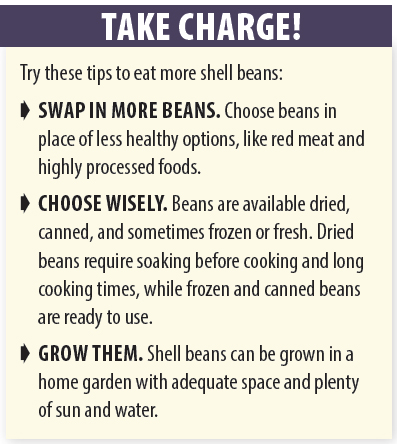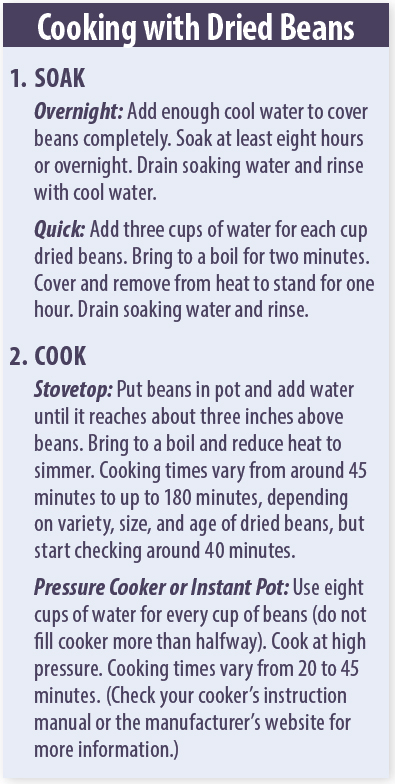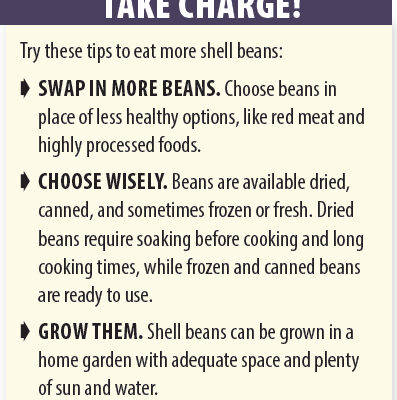Get to Know Shell Beans
From the familiar navy, pinto, and lima beans to soybeans and heirloom varieties like scarlet runner and purple pod, beans are part of the legume family (along with lentils, peas, and peanuts). Shell beans are any variety grown for shelling, as opposed to those eaten in the pod (like green beans, snow peas, and snap beans). Shell beans are packed with nutrients, including fiber, protein, folate, iron, potassium, magnesium, and numerous beneficial phytonutrients.

According to a recent review and meta-analysis, eating an average of threequarters of a cup of cooked common shell beans (predominantly navy beans, red beans, and pinto beans) a day over a range of four to eight weeks decreased LDL cholesterol by 19 percent. In a study that included 19 years of follow-up, consuming cooked dry beans such as pinto and red beans was associated with an 11 percent lower rate of cardiovascular disease. “To reap these benefits,” says Alice H. Lichtenstein, DSc, senior scientist and director of the Cardiovascular Nutrition Laboratory at the HNRCA and executive editor of Tufts Health & Nutrition Letter, “strategically substitute shell beans for other foods such as processed meats and refined carbohydrates.”
Store-Bought Beans.
One of the cheapest proteins you can buy, beans are available dried, canned, and sometimes—as with edamame (green soybeans), lima beans, and black-eyed peas—frozen. Edamame can be found fresh in the produce section of many markets. “Dried beans, the most economical, are usually available in one pound bags,” says Lichtenstein. “They typically require soaking for several hours before they’re cooked to soften them” (see Cooking with Dried Beans). Canned beans are ready to eat—just drain and rinse to wash away excess sodium and gas-producing compounds. Thaw frozen beans before use or simply increase cooking time.

Grow Beans at Home.
Shell beans can be grown in a home garden. Fresh shell beans have a slightly different flavor from dried or canned beans: subtly sweeter and creamier. In addition to providing beans that nourish us, bean plants nourish and improve the soil by promoting production of nitrogen. These five tips can help you get started growing your own shell beans:
1. Choose a spot. Find an unshaded spot where plants can be spaced as directed. Pole beans will need support.
2. Get climate-friendly varieties. Different beans are suited to different planting zones. Your local gardening store or extension service (a department of a local university or county designed to support agriculture) can offer guidance on varieties that will grow best in your area.
3. Keep soil moist. Beans grow well in moist soil, so water consistently, especially in warm temperatures. Adding mulch or compost can help preserve soil moisture and prevent weeds.
4. Be watchful. Control weeds and pests as needed to protect your plants so they make it to harvest.
5. Harvest. Pick fresh beans (after about 60-70 days) while the pods are plump and still tender, shuck, and add to your favorite recipes. Use immediately, refrigerate up to three days, can, or blanch and freeze. To dry beans, leave the pods to dry on the plant. Pick them after the pods have dried and the entire plant has turned completely brown. You can also dry shucked beans on a tray in the sun or in a food dehydrator. Store them up to three years in airtight containers.
If gardening is not an option, dried, canned, and frozen beans are always a good addition to a healthy dietary pattern.
The post Get to Know Shell Beans appeared first on University Health News.


